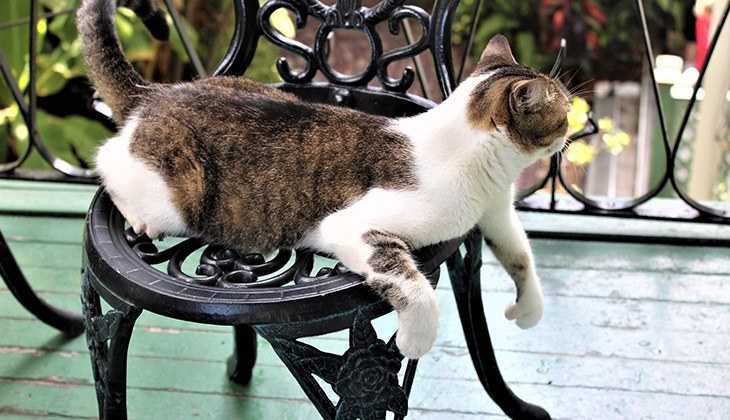
How Cats Get Fleas Indoors
HEALTH & PROTECTION
9 Mar, 2020
READ 5 minutes
As far as fleas are concerned, your indoor cat is fair game. Just because your cat doesn’t romp through the wild doesn’t mean that your indoor cat won’t get cat fleas in your house. Cat fleas are the most common types of fleas found on cats, dogs, and wildlife. Many people think that their indoor cat can’t catch fleas, so they don’t use any sort of flea protection. Unfortunately, fleas are very good at catching cats, even when they never leave home. Here are five places in your home where fleas can quickly jump on your indoor cat.
LAYING NEAR AN OPEN WINDOW
Let’s get something straight: insect screens are no match for fleas.
Fleas are so tiny that they can easily jump through the screen and land on your cat, especially if the window is at the basement or ground level, if it is surrounded by long grass or bushes, or if there is a chance that other wild animals, such as mice, rats, and rabbits, might wander by leaving a trail of flea eggs behind. It happens more often than you might think.
Fleas can’t fly, but they can jump up to 7 inches (18 cm) high and 13 inches (33 cm) across. Adult cat fleas locate their host by visual and thermal cues. They jump on your cat skin to quickly consume blood. The flea’s body is small and flat, and it helps it to glide effortlessly down between the hair shafts to reach the skin and begin consuming a blood meal quickly. Once the flea reaches the skin, it stays against the skin, moving between the shafts the way a cat might move through a forest: easily and well-hidden. If your cat has dark fur, it will be very difficult for you to see a flea on it.
PLAYING, LOUNGING, OR SLEEPING INSIDE A SCREENED-IN PORCH
Just when you think your indoor cat is safe from the wild, a flea jumps in through the screen and proves otherwise. Fleas can be anywhere inside your screened-in porch, just waiting for a warm host to land on. Fleas are tiny, blood-sucking parasites that are more often found on four-legged animals, but if push comes to shove, they’ll consume a meal on a living, breathing two-legged creature, like you! When fleas feed on humans, they tend to settle on thin skin, on the wrists or ankles, because it’s easier for them to penetrate and consume a meal.
WALKING BY AN OPEN DOOR
Every time you open the door to the outside world, a flea can wander into your cozy space. It’s true. Fleas jump through open doors when they sense body heat, vibration, and breathing, which is every time a door is opened. Once a flea is inside, it will find a host to feed on. If your indoor cat is not protected from fleas, there is a very good chance that a flea will feed on your cat.
INTERACTING WITH OTHER ANIMALS
Other animals, whether they live in your home, or visit occasionally, can bring fleas into your home. The minute another animal with fleas enters your space, fleas begin to infest your living areas.
THE LIFE CYCLE OF FLEAS IS CONTINUOUS
Twenty-four hours after an adult flea consumes a blood meal, she will begin to lay up to 50 eggs. This is a cycle that every female adult flea goes through, so it’s never just one flea consuming a meal and laying eggs on an animal, it’s many fleas consuming meals and laying eggs. The eggs are sticky at first, but they dry and roll off the fur and hair and land, well, just about everywhere.
Imagine a dog with fleas entering your home and playing a little game of chase with your cat— everywhere the dog runs, the eggs will fall. Once the itty-bitty eggs land on the floor, they fall into the carpet and crevices where they stay for up to ten days. Then they hatch into equally tiny larvae that burrow even deeper into the carpeting, furniture, and bedding, as they look to consume flea dirt, which is really flea faeces. Soon, they spin a cocoon and enter into the pupae stage. Once they hatch as an adult flea, the process of jumping on a host and consuming the first meal so that eggs can be laid begins all over again. Of course, this is only the cycle of one flea. Eventually, it becomes the cycle of hundreds of fleas. This is why fleas are such a problem once they enter your home.

LAYING NEAR OR IN YOUR LAUNDRY PILE
Those muddy pants you threw into the laundry pile or the socks from last night’s soccer game heaped in a pile on the bedroom floor might have a few fleas clinging on them for dear life, just waiting to jump on the potential host as soon as she or he decides to take a little nap. Fleas look like little pieces of dirt, which means that your laundry pile is really the perfect camouflage.
If you suspect that your cat has fleas seek treatment immediately and begin the process of eliminating fleas in all forms (eggs, larvae, and pupae) from your home. The process can take up to three months or more.
Although it may seem that fleas can sneak in and catch your cat off guard, the situation is far from hopeless. You can talk to your veterinarian about the best options to keep your cat and your home protected 24/7, 365 days a year. The only thing better than that is to begin treatment before the first flea glides into your home because that’s the only way to prevent the life cycle from starting in the first place.
RECOMMENDED




